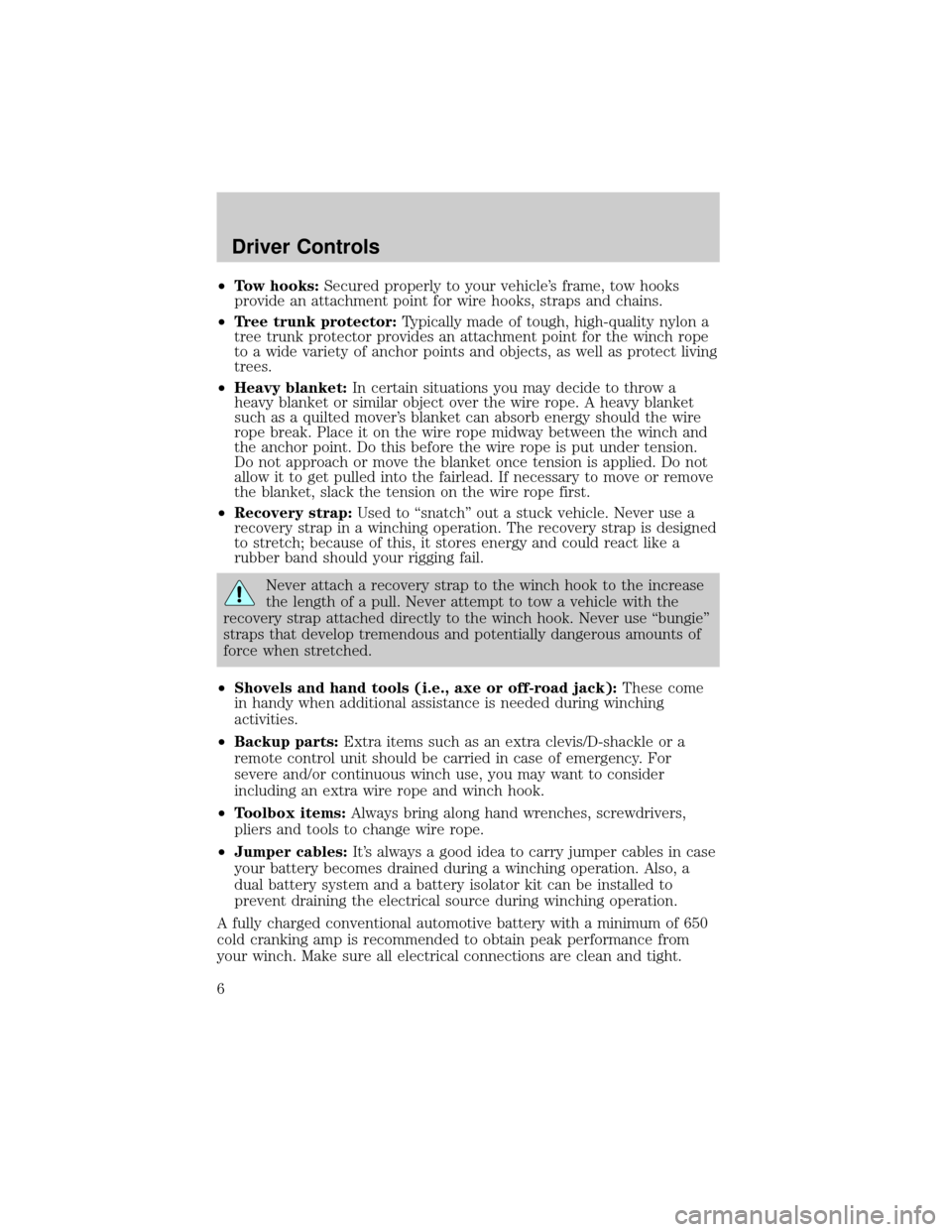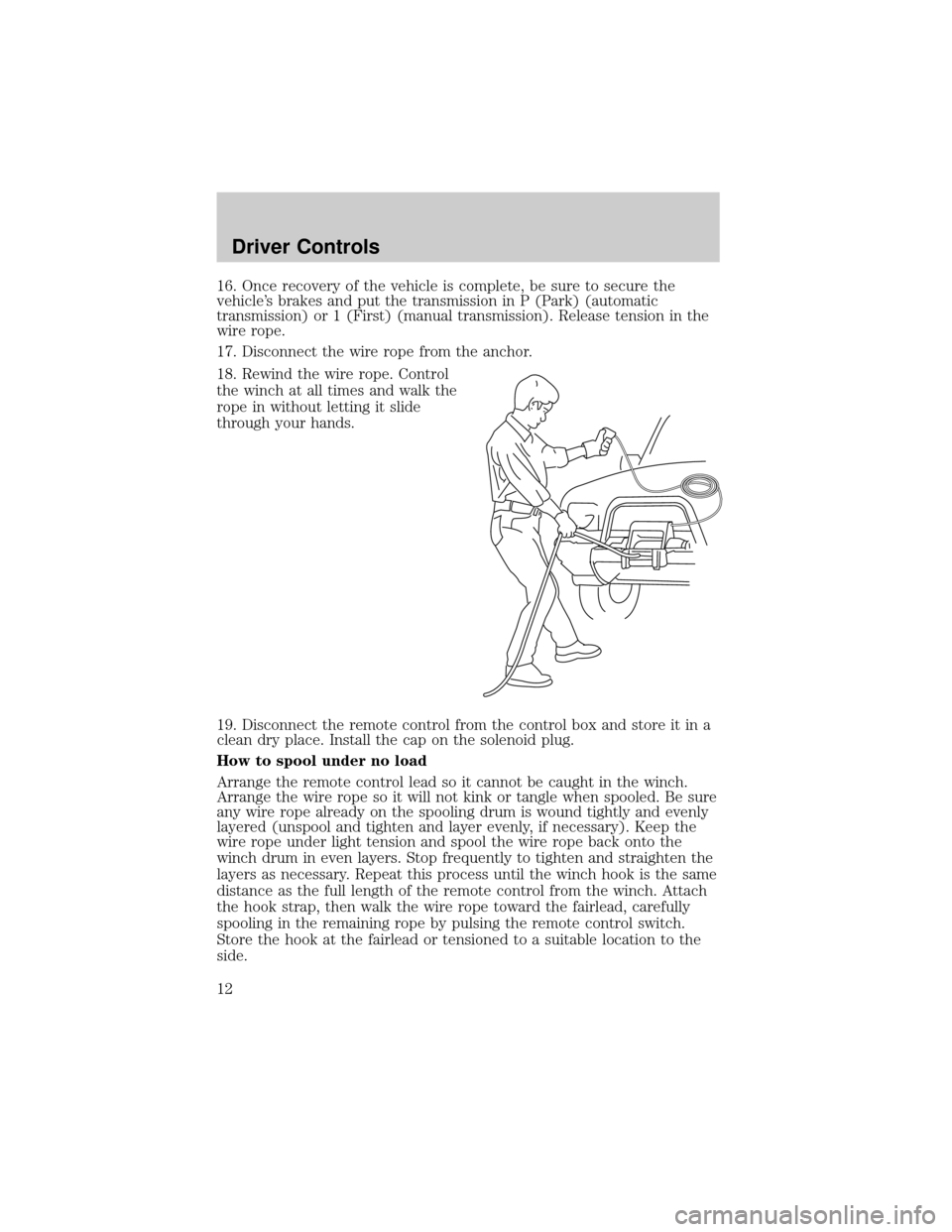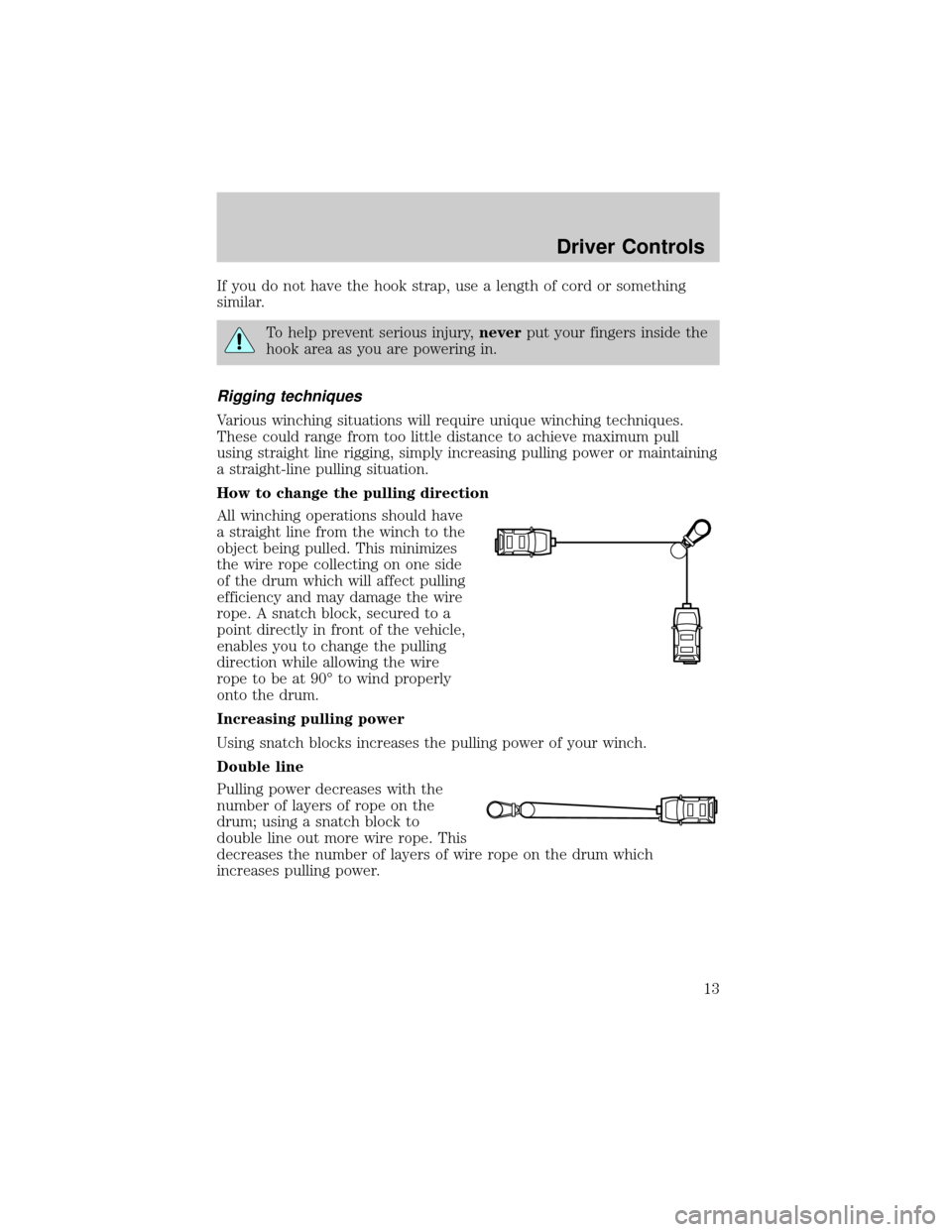Page 6 of 28

²Tow hooks:Secured properly to your vehicle's frame, tow hooks
provide an attachment point for wire hooks, straps and chains.
²Tree trunk protector:Typically made of tough, high-quality nylon a
tree trunk protector provides an attachment point for the winch rope
to a wide variety of anchor points and objects, as well as protect living
trees.
²Heavy blanket:In certain situations you may decide to throw a
heavy blanket or similar object over the wire rope. A heavy blanket
such as a quilted mover's blanket can absorb energy should the wire
rope break. Place it on the wire rope midway between the winch and
the anchor point. Do this before the wire rope is put under tension.
Do not approach or move the blanket once tension is applied. Do not
allow it to get pulled into the fairlead. If necessary to move or remove
the blanket, slack the tension on the wire rope first.
²Recovery strap:Used to ªsnatchº out a stuck vehicle. Never use a
recovery strap in a winching operation. The recovery strap is designed
to stretch; because of this, it stores energy and could react like a
rubber band should your rigging fail.
Never attach a recovery strap to the winch hook to the increase
the length of a pull. Never attempt to tow a vehicle with the
recovery strap attached directly to the winch hook. Never use ªbungieº
straps that develop tremendous and potentially dangerous amounts of
force when stretched.
²Shovels and hand tools (i.e., axe or off-road jack):These come
in handy when additional assistance is needed during winching
activities.
²Backup parts:Extra items such as an extra clevis/D-shackle or a
remote control unit should be carried in case of emergency. For
severe and/or continuous winch use, you may want to consider
including an extra wire rope and winch hook.
²Toolbox items:Always bring along hand wrenches, screwdrivers,
pliers and tools to change wire rope.
²Jumper cables:It's always a good idea to carry jumper cables in case
your battery becomes drained during a winching operation. Also, a
dual battery system and a battery isolator kit can be installed to
prevent draining the electrical source during winching operation.
A fully charged conventional automotive battery with a minimum of 650
cold cranking amp is recommended to obtain peak performance from
your winch. Make sure all electrical connections are clean and tight.
Driver Controls
6
Page 12 of 28

16. Once recovery of the vehicle is complete, be sure to secure the
vehicle's brakes and put the transmission in P (Park) (automatic
transmission) or 1 (First) (manual transmission). Release tension in the
wire rope.
17. Disconnect the wire rope from the anchor.
18. Rewind the wire rope. Control
the winch at all times and walk the
rope in without letting it slide
through your hands.
19. Disconnect the remote control from the control box and store it in a
clean dry place. Install the cap on the solenoid plug.
How to spool under no load
Arrange the remote control lead so it cannot be caught in the winch.
Arrange the wire rope so it will not kink or tangle when spooled. Be sure
any wire rope already on the spooling drum is wound tightly and evenly
layered (unspool and tighten and layer evenly, if necessary). Keep the
wire rope under light tension and spool the wire rope back onto the
winch drum in even layers. Stop frequently to tighten and straighten the
layers as necessary. Repeat this process until the winch hook is the same
distance as the full length of the remote control from the winch. Attach
the hook strap, then walk the wire rope toward the fairlead, carefully
spooling in the remaining rope by pulsing the remote control switch.
Store the hook at the fairlead or tensioned to a suitable location to the
side.
Driver Controls
12
Page 13 of 28

If you do not have the hook strap, use a length of cord or something
similar.
To help prevent serious injury,neverput your fingers inside the
hook area as you are powering in.
Rigging techniques
Various winching situations will require unique winching techniques.
These could range from too little distance to achieve maximum pull
using straight line rigging, simply increasing pulling power or maintaining
a straight-line pulling situation.
How to change the pulling direction
All winching operations should have
a straight line from the winch to the
object being pulled. This minimizes
the wire rope collecting on one side
of the drum which will affect pulling
efficiency and may damage the wire
rope. A snatch block, secured to a
point directly in front of the vehicle,
enables you to change the pulling
direction while allowing the wire
rope to be at 90É to wind properly
onto the drum.
Increasing pulling power
Using snatch blocks increases the pulling power of your winch.
Double line
Pulling power decreases with the
number of layers of rope on the
drum; using a snatch block to
double line out more wire rope. This
decreases the number of layers of wire rope on the drum which
increases pulling power.
Driver Controls
13
Page 21 of 28

WHEELS
Your vehicle may be equipped with two-piece bolt-together beadlock
rims. Beadlock rims allow the tires to survive operating at lower air
pressure which provide greater traction due to the larger tire-to-ground
contact area during slow, off-road operation. Always reinflate the tires to
the tire manufacturer's recommendations when no longer in slow,
off-road driving conditions. The beadlock also acts as a safety device
ensuring that the tire does not unseat from the rim or rotate on the
wheel when tire pressure is reduced, while also preventing the entry of
foreign objects, debris or water into the tire's air chamber.
Note:The wheel/tire assemblies should be serviced only by trained
personnel who have read and understand the wheel
assembly/disassembly information contained within theWorkshop
Manual.
TIRES
Each tire is equipped with a Variable Function Insert (VFI) which is
mounted into the tire. The VFI insert and tire are then fitted around the
beadlock rim assembly, providing a higher level of tire protection due to
the dense rubber material in the tire assembly and maximum all-terrain
mobility.
SNOW CHAINS
Tire chains cannot be used on vehicles equipped with M/TR tires.
ON-BOARD AIR SYSTEM (IF EQUIPPED)
Your vehicle may be equipped with an on-board air system which has
been designed to provide compressed air for multiple uses, including the
addition of air to the vehicle's tires. The system uses a 25 ft. (7.6m)
length of air hose equipped with a clamp-on style air chuck. When not in
use, this hose is secured to the floor of the truck. A compressor,
mounted to the frame under the truck on the passenger side frame rail,
is included along with an air reservoir on the driver side. When the
compressor is on, the output pressure at the air tank is limited to 80 psi
(552 kPa).
Tires, Wheels and Loading
21